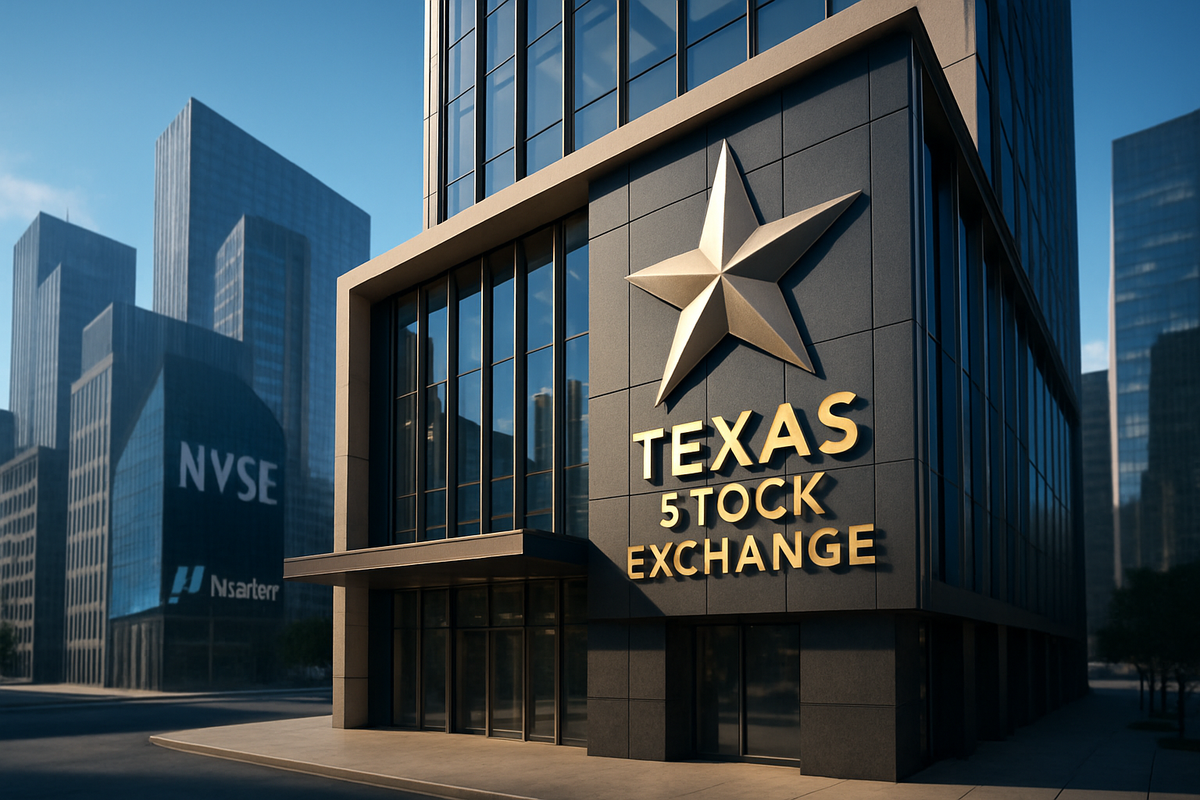
The financial landscape of the United States is on the cusp of a significant transformation with the recent federal approval of the Texas Stock Exchange (TXSE). On September 30, 2025, the U.S. Securities and Exchange Commission (SEC) granted its blessing to the TXSE, clearing the path for the first new, fully integrated U.S. stock exchange in decades and the only one to be headquartered in Texas. This landmark decision sets the stage for the TXSE to commence trading, including exchange-traded products (ETPs) and corporate listings, as early as 2026. The immediate implications are profound, signaling an era of increased competition in the equity markets and a potential shift in financial power away from traditional hubs.
The TXSE's emergence is a direct challenge to the long-standing duopoly of the New York Stock Exchange (NYSE) (NYSE: ICE) and Nasdaq (NASDAQ: NDAQ). Its core mission is to introduce greater competition and innovation, making it easier and more cost-effective for companies to go public and remain publicly traded. This initiative aims to reverse a decades-long decline in the number of U.S. public companies by offering a compelling alternative for both domestic and global enterprises. With substantial financial backing from industry titans like BlackRock (NYSE: BLK), Citadel Securities, and Charles Schwab (NYSE: SCHW), the TXSE is well-capitalized to disrupt the established order and usher in a new chapter of market dynamics.
A New Contender Emerges: Unpacking the TXSE's Strategic Play
The federal approval of the Texas Stock Exchange on September 30, 2025, represents the culmination of years of planning and strategic positioning. This pivotal moment allows the TXSE to proceed with its ambitious plans, with an operational launch expected to begin in the first quarter of 2026. The exchange plans to introduce trading services for stocks and ETPs initially, followed by the rollout of indices and additional ETPs in the second quarter, and corporate listings in the latter half of 2026. This phased approach underscores a meticulous strategy to build a robust and reliable trading ecosystem.
The genesis of the TXSE is rooted in a desire to address perceived shortcomings within the existing exchange framework, particularly the high costs and regulatory complexities associated with listing on NYSE and Nasdaq. The TXSE aims to provide a more business-friendly environment, leveraging Texas' pro-business policies, lower taxes, and burgeoning infrastructure. Its proprietary order matching engine and exchange platform are designed for low-latency performance, flexibility, and scalability, promising a world-class trading experience. Key players involved in this venture include its founders and a consortium of investors providing over $120 million in capital, highlighting significant industry confidence in its potential. Initial market reactions have been a mix of anticipation and cautious optimism, with many observers acknowledging the potential for a genuine shake-up in the market structure, while others await concrete evidence of its ability to attract substantial listings and liquidity.
Market Movers: Companies Poised to Win or Lose from the TXSE
The advent of the Texas Stock Exchange is set to reshape the competitive landscape for public companies, creating distinct opportunities and challenges across various sectors. The TXSE's focus on cost-effective listings and a pro-business environment will undoubtedly influence listing decisions and capital-raising strategies.
Small and Mid-Sized Enterprises (SMEs), particularly those within Texas and the broader Sun Belt region, are poised to be significant winners. The TXSE's promise of lower listing and compliance costs, coupled with potentially less burdensome regulatory requirements, could open doors to public market access that were previously prohibitive. This means reduced financial barriers, fostering growth and innovation for companies that might have struggled to justify the expense of listing on established exchanges. These firms could gain access to capital essential for expansion, driving job creation and economic development.
Texas-based companies across the state's robust economic sectors—including energy, technology, healthcare, and advanced manufacturing—are also natural beneficiaries. A "local" listing option on the TXSE could enhance their regional identity and brand alignment, attracting a new pool of local and regional investors keen on supporting Texas enterprises. While unlikely to abandon their primary listings, giants like Dell Technologies (NYSE: DELL), ExxonMobil (NYSE: XOM), and AT&T (NYSE: T) might consider secondary listings on the TXSE to strengthen their local presence or engage with a specific regional investor base. Furthermore, emerging growth companies and IPO candidates will find a new, potentially more accessible pathway to public markets, aligning with the TXSE's mission to reverse the decline in U.S. public companies.
Conversely, the most direct impact will be felt by the incumbent exchanges, the New York Stock Exchange (NYSE) (NYSE: ICE) and Nasdaq (NASDAQ: NDAQ). The TXSE's explicit goal to compete for new corporate listings and trading volume could gradually erode their market share. This increased competition is likely to pressure NYSE and Nasdaq to innovate, potentially leading to reduced listing fees, enhanced service quality, and advancements in trading technology to retain and attract companies. In anticipation, both established exchanges have already begun responding, with NYSE launching "NYSE Texas" in Dallas and Nasdaq planning a regional headquarters there, underscoring the seriousness of the competitive threat. Companies that solely rely on the perceived prestige and deep liquidity of current exchanges might also face strategic decisions if the TXSE successfully builds credibility and offers compelling advantages.
Wider Significance: Reshaping the Financial Ecosystem
The federal approval of the Texas Stock Exchange (TXSE) transcends a mere addition to the existing market infrastructure; it represents a pivotal moment that could fundamentally reshape the broader financial ecosystem. This event fits squarely into a broader trend of financial market decentralization and the emergence of new economic power centers beyond traditional East Coast hubs. Texas, with its burgeoning economy and pro-business policies, has been aggressively positioning itself as a formidable financial services hub, often dubbed "Y'all Street." The TXSE's arrival solidifies this ambition, potentially accelerating the migration of corporate interests and wealth to the state.
The ripple effects on competitors and partners are already evident. The New York Stock Exchange (NYSE) (NYSE: ICE) and Nasdaq (NASDAQ: NDAQ), the long-standing duopoly, are now faced with their most significant challenger in decades. Their proactive measures, such as establishing a physical presence in Texas, highlight their recognition of the threat. This intensified competition is likely to spur innovation across all exchanges, potentially leading to more competitive listing fees, improved trading technologies, and enhanced services for issuers and investors alike. For financial technology (FinTech) companies, the TXSE presents both new partnership opportunities and a fresh landscape for developing market-making and trading solutions tailored to its platform.
Regulatory and policy implications are also substantial. The SEC's approval signifies a regulatory willingness to foster competition within a highly concentrated market. This could set a precedent for future market innovations and potentially influence regulatory approaches to exchange operations, data pricing, and market access. The TXSE's stated aim to offer a less burdensome regulatory environment, while maintaining high standards, could also prompt a re-evaluation of existing compliance requirements across the industry. Historically, new exchanges have often emerged during periods of economic dynamism or technological shifts, but rarely with such significant backing and a clear strategic focus on challenging the incumbents head-on. Comparisons can be drawn to past attempts to create alternative trading systems, but the TXSE's integrated exchange model and substantial capital base differentiate it significantly, suggesting a more enduring impact than previous ventures.
What Comes Next: Navigating a New Market Frontier
The federal approval of the Texas Stock Exchange ushers in an exciting yet uncertain period for the U.S. financial markets. In the short term, the immediate focus will be on the TXSE's operational launch, with trading of exchange-traded products (ETPs) and stocks expected in the first quarter of 2026, followed by corporate listings later that year. The success of this initial phase will be crucial in building confidence and attracting liquidity. Market participants, including investors, brokers, and institutional traders, will closely monitor trading volumes, bid-ask spreads, and the overall efficiency of the TXSE's proprietary platform.
In the long term, the TXSE's trajectory will depend heavily on its ability to attract a consistent flow of high-quality corporate listings. Its strategy of targeting small and mid-sized enterprises (SMEs), particularly those in the Southern U.S. and sponsor-backed companies, will be put to the test. Should it succeed, we could see a significant shift in where companies choose to go public, potentially leading to a more diversified and geographically distributed public company base. Strategic pivots will be required from both the TXSE to refine its offerings and from existing exchanges to counter the competitive threat. NYSE (NYSE: ICE) and Nasdaq (NASDAQ: NDAQ) will likely continue to innovate and potentially adjust their fee structures or listing requirements to retain their market dominance.
Market opportunities will emerge for investment banks specializing in IPOs for smaller companies, as well as for regional brokers who may find new avenues for client engagement. Challenges will include establishing sufficient liquidity to ensure fair pricing and efficient trading, as well as overcoming the ingrained habits and preferences of investors accustomed to the established exchanges. Potential scenarios range from the TXSE becoming a niche player for regional listings, to it evolving into a formidable third national exchange that fundamentally alters market structure. The most optimistic outcome sees the TXSE fostering a more vibrant IPO market, particularly for companies that have historically found the public path too arduous or expensive.
A New Dawn for U.S. Equity Markets
The federal approval of the Texas Stock Exchange on September 30, 2025, represents a monumental shift in the landscape of U.S. equity markets. The key takeaway is the introduction of a powerful new competitor, poised to challenge the long-standing duopoly of NYSE (NYSE: ICE) and Nasdaq (NASDAQ: NDAQ). This move is not merely about adding another trading venue; it's about fostering greater competition, potentially lowering listing costs, and creating a more accessible pathway for companies to go public, particularly for small and mid-sized enterprises and those rooted in the rapidly growing Texas economy.
Moving forward, the market is set to become more dynamic and responsive. The TXSE's launch in 2026 will be a critical period, as it seeks to establish liquidity and attract its first wave of corporate listings. Its success could usher in an era where companies have more choice in where to list, potentially leading to a more diversified and robust public market. This could also force existing exchanges to innovate further, ultimately benefiting investors through improved services and potentially more efficient markets.
The lasting impact of the TXSE could be profound, signaling a decentralization of financial power and solidifying Texas's position as a major financial hub. Investors should closely watch several key indicators in the coming months: the types and number of companies that choose to list on the TXSE, the liquidity and trading volumes achieved on its platform, and the competitive responses from NYSE and Nasdaq. The performance of companies in sectors strong in Texas, such as energy and technology, that might consider a TXSE listing will also be a crucial barometer of its initial success. This development promises a fascinating period of evolution for the U.S. capital markets, with potential benefits for companies, investors, and the broader economy.
This content is intended for informational purposes only and is not financial advice





